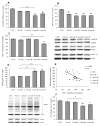Deterioration of plasticity and metabolic homeostasis in the brain of the UCD-T2DM rat model of naturally occurring type-2 diabetes
- PMID: 24840661
- PMCID: PMC4372388
- DOI: 10.1016/j.bbadis.2014.05.007
Deterioration of plasticity and metabolic homeostasis in the brain of the UCD-T2DM rat model of naturally occurring type-2 diabetes
Abstract
The rising prevalence of type-2 diabetes is becoming a pressing issue based on emerging reports that T2DM can also adversely impact mental health. We have utilized the UCD-T2DM rat model in which the onset of T2DM develops spontaneously across time and can serve to understand the pathophysiology of diabetes in humans. An increased insulin resistance index and plasma glucose levels manifested the onset of T2DM. There was a decrease in hippocampal insulin receptor signaling in the hippocampus, which correlated with peripheral insulin resistance index along the course of diabetes onset (r=-0.56, p<0.01). T2DM increased the hippocampal levels of 4-hydroxynonenal (4-HNE; a marker of lipid peroxidation) in inverse proportion to the changes in the mitochondrial regulator PGC-1α. Disrupted energy homeostasis was further manifested by a concurrent reduction in energy metabolic markers, including TFAM, SIRT1, and AMPK phosphorylation. In addition, T2DM influenced brain plasticity as evidenced by a significant reduction of BDNF-TrkB signaling. These results suggest that the pathology of T2DM in the brain involves a progressive and coordinated disruption of insulin signaling, and energy homeostasis, with profound consequences for brain function and plasticity. All the described consequences of T2DM were attenuated by treatment with the glucagon-like peptide-1 receptor agonist, liraglutide. Similar results to those of liraglutide were obtained by exposing T2DM rats to a food energy restricted diet, which suggest that normalization of brain energy metabolism is a crucial factor to counteract central insulin sensitivity and synaptic plasticity associated with T2DM.
Keywords: Dietary energy restriction; Energy homeostasis; Insulin signaling; Liraglutide; Plasticity; Type-2 diabetes.
Copyright © 2014 Elsevier B.V. All rights reserved.
Conflict of interest statement
There is no conflict of interest for any of the contributing authors.
Figures







References
-
- Cummings BP, Digitale EK, Stanhope KL, Graham JL, Baskin DG, Reed BJ, Sweet IR, Griffen SC, Havel PJ. Development and characterization of a novel rat model of type 2 diabetes mellitus: the UC Davis type 2 diabetes mellitus UCD-T2DM rat. Am J Physiol Regul Integr Comp Physiol. 2008;295:R1782–1793. - PMC - PubMed
Web Reference
-
- Estimating the maximum safe starting dose in initial clinical trials for therapeutics in adult healthy volunteers. The guidance for industry by the office of new drugs in the center for drug evaluation and research (CDER) at the food and drug administration, Rockville, Maryland, USA. Pharmacology and Toxicology. 2005 Jul; URL: http://www.fda.gov/downloads/Drugs/Guidance/UCM078932.pdf.
Publication types
MeSH terms
Substances
Grants and funding
LinkOut - more resources
Full Text Sources
Other Literature Sources
Medical

